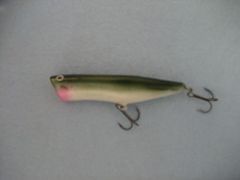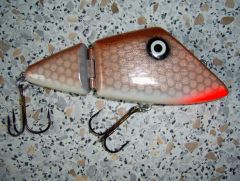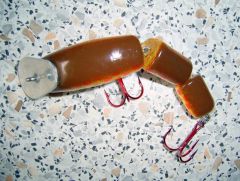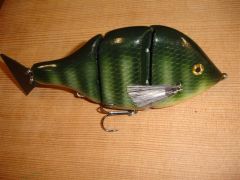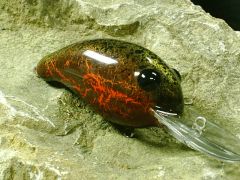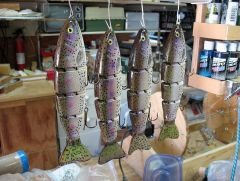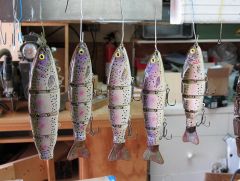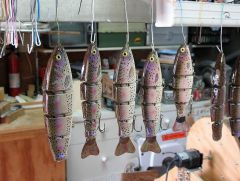-
Posts
14,726 -
Joined
-
Last visited
-
Days Won
364
Content Type
Profiles
Articles
TU Classifieds
Glossary
Website Links
Forums
Gallery
Store
Everything posted by mark poulson
-
-
-
Maybe hitting it with a hair dryer on high first would speed up the process.
-
That lure looks great. You can add some more weight by taking out the tail hook, drilling it out to accept a mojo-type cylindrical sinker, and then put a longer screw eye in back through the sinker. You can figure out how much weight to add by hanging lead split shot on the tines of the rear treble until it hangs almost vertical, but still floats. That way it will cast well, and pop well, too. If you want to see how it should hang, check out a commercial popper of the same size, and see how it hangs in the water. Then match that. That will give you a good starting point. Don't be afraid to redo things. I have a garage full of failures, and a boat load full of successful rescues. And don't be discouraged. You'll learn from every mistake, and get better results because of them. I think we all learn more from our mistakes than our successes. That's probably why we make more of them.
-
Man, that thing swims great!
-
I think part of your problem is that const. grade lumber has a very wide grain pattern, since it's been developed to grow big fast, so the growth rings are widely spaced, and there is a lot of soft summer growth between the harder winter bands. When you shape a softer wood like that, it's really hard not to remove more of the soft wood, which accentuates the grain pattern. When I made lures from Douglas Fir, I used really old, tight grained wood that I salvaged from jobsites. Old growth timber has a much tighter grain pattern. Even then, the grain can still show through. I sealed my wood lures with Minwax Wood Hardener, let them dry well, and resanded with fine paper that's curved to follow the curves of the lure, to minimized the removal of the softer wood between the grain. But having the grain telegraph through is inevitable. So I sprayed on a sandable primer, used 200 grit paper to even the surface out, and reprime. That seemed to minimize the grain issue. All this effort to get a smooth blank is another reason I switched to AZEK PVC decking (thank you JR).
-
Dean, Thanks for the kind words. The lakes I fish are mostly clear, but get a decent algae green color in late spring/early summer, and keep it until late fall. Warm water and sunlight work wonders. The paint schemes I do need some light to really shine, since they rely on the on again/off again flash of the iridescent paint to act as a trigging mechanism. I have some of these lures in the hands of some pretty accomplished big bait guys now, so I hope to have some positive feedback soon. Of course, it's really past prime swimbait season here (late winter/early spring), but the big girls are still around. They're just more active when trout are being planted, and that's just about done for the season. 78 degrees is the water temperature cutoff for trout plants, and we're up to 72 now, with hot, sunny days ahead.
-
-
-
-
Congratulations!!! It looks great! I'm glad your hinges worked out. As for an erratic retrieve, in crankbaits that's know as hunting, where the water going over the bill is right at the edge of instability, and the crank changes direction and starts swimming again erratically. Those baits are pure gold! You're right. Predators love wounded prey. Much easier to catch. That action should draw them like a magnet. In the future, you can "reintroduce" buoyancy by drilling holes in the sinking sections and capping them with aluminum can discs made with a hole punch, and super glue. That traps air, making them more buoyant.
-
-
-
-
I think it's a matter of solvents. Lacquer, obiously, is a laquer thinner solvent paint, and the epoxy is alcohol solvent. I've sprayed Wildlife Colors iridescents directly over clear crank bodies, and then epoxied them, with no problems. The epoxies we use generally are alcohol solvent based, and the heat set paints don't seem to be bothered by the alcohol, once they've been set. I think that the top coat is only to protect the paint from abrasion, instead of from the water, since the heat set paint is waterproof. Having said that, I'm too chicken to take a chance after I've painted a lure to fish it without a top coat. A light spray of iridescent violet over a cleared crank, and then epoxy, makes a great ghost color.
-
-
-
Thank you both for the nice words. I'm sorry the iridescent stripe on the side didn't photograph better. When I hold it in my hand, and turn it, it really stands out at different angles. While I don't think the color itself is important, the flash should be an attractant, and maybe get a strike. I've caught a 1 1/2lb largemouth on one, and a 7 lb largemouth is the biggest I've caught. I don't know about what others have caught on them, but a friend caught a 2lb largemouth on my boat last month throwing one of my 7" trout baits. According to Bill Siemental, catching swimbait fish is more a matter of right place, right time, right type of presentation than the specific lure. He says lures are tools, and using them at the right time is the key. I saw Paul Bailey, one of the Big Bait Posse, catch a 10lber with an old floating, one piece swimbait that had lost it's lip. He just threw it out, let it sit, twitched it once, and bam, the fish explosed on it. I do the elaborate paint jobs because guys like them. I'm not sure the fish care, except on the really clear lakes like Castaic and Casitas, and, even then, only on the dead stick floaters that sit for minutes at a time between twitches. Action catches the fish, paint jobs catch the fishermen.
-
That looks great. Nice paint job, too. Certainly doesn't look like a first time lure! It should really swim well with that bill. I hear you about the pain involved in hinging. That's why I settled on screw eyes and hinge pins. Simple, easy to adjust, and they swim really well. I am lazy. I didn't start out to reinvent the wheel, just adapt whatever worked to make lures that work, as quickly and easily, and reliably, as possible.
-
-
-
Here's the last batch I made. The two on the left are floaters, and weigh 135 grams, and the two on the right are sinkers, and weigh 155 grams. They are from AZEK. The hooks are Mustad 3/0, the tails are from Captsully, the eyes are from Predator Bass. The two sinkers were made to order, and have a lateral line of Wildlife Colors iridescent violet, which is also the accent color on the heads, where it shows up better in these photos. The lines down the sides flash on and off depending on the light. The two floaters are for stock. I played around with trying to make them look like a juvenile trout, with more pronounced spots on the sides.
-
Here's the last batch I made. The two on the left are floaters, and weigh 135 grams, and the two on the right are sinkers, and weigh 155 grams. They are from AZEK. The hooks are Mustad 3/0, the tails are from Captsully, the eyes are from Predator Bass. The two sinkers were made to order, and have a lateral line of Wildlife Colors iridescent violet, which is also the accent color on the heads, where it shows up better in these photos. The lines down the sides flash on and off depending on the light. The two floaters are for stock. I played around with trying to make them look like a juvenile trout, with more pronounced spots on the sides.
-
Here's the last batch I made. The two on the left are floaters, and weigh 135 grams, and the two on the right are sinkers, and weigh 155 grams. They are from AZEK. The hooks are Mustad 3/0, the tails are from Captsully, the eyes are from Predator Bass. The two sinkers were made to order, and have a lateral line of Wildlife Colors iridescent violet, which is also the accent color on the heads, where it shows up better in these photos. The lines down the sides flash on and off depending on the light. The two floaters are for stock. I played around with trying to make them look like a juvenile trout, with more pronounced spots on the sides.






